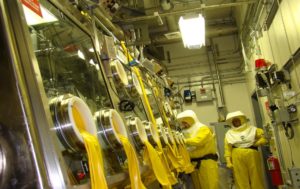Plutonium is flammable, so there will be risks to SRS workers, the environment and public if SRS ever processes plutonium into “pits” for new nuclear warheads, part of the US effort to stoke a new nuclear arms race. The effort to build the SRS Plutonium Bomb Plant is far behind schedule and far over budget. It may not operate, if ever, until 2026. And, a cost estimate of around $17 billion – to convert the plutonium fuel (MOX) building into a bomb plant – is not out of line with funding levels by Congress.
“Glove box fire closed part of Los Alamos National Laboratory plutonium facility in November
Santa Fe New Mexican
Dec. 19, 2023—A sealed compartment with safety gloves attached caught fire at Los Alamos National Laboratory in November, resulting in officials shutting down a portion of the site’s plutonium facility for 10 days, according to the lab’s and government watchdogs’ reports.
Employees were pulverizing 40-year-old legacy materials that were removed from the facility to create more storage and work space when they saw a flash and then a fire inside one of the glove boxes they were using for the task, according to a Defense Nuclear Facilities Safety Board report.
They deactivated the equipment, sounded alarms and promptly left the room. They and other facility workers evacuated the building.
The Los Alamos County Fire Department responded, and when a team arrived the fire was out, with no apparent damage to the glove box, a lab spokesman wrote in an email.
There was no evidence of anyone being contaminated or breathing in any radioactive toxins in the Nov. 6 incident, the safety board said.
The work area was closed off for 10 days while technical teams probed it. During that time, Triad National Security LLC, the lab’s primary contractor, began developing a recovery plan.
In an email, lab spokesman Steven Horak wrote personnel train for these sorts of incidents, and the facility has built-in protections.
“The facility and its safety systems functioned exactly as planned, with no impact to other rooms in the building nor the general public,” Horak wrote.
The likely cause of the fire was an energetic reaction from calcium metal contained in the feed material, the safety board said.
Engineering personnel have determined the glove box is still maintaining the proper air pressure but have recommended replacing all filters and gloves as well as glove box windows closest to the event, the board said.
One discrepancy is the lab and safety board say the affected work area was reopened Nov. 16, while an incident report said the room was restricted until Nov. 20.
Another glove box incident occurred a week after the fire.
While preparing to package materials, a worker lost control of a container inside the glove box, causing it to slam against the window. It cracked the inner safety glass and shattered the outer leaded glass window used as radiation shielding, the board reported.
Surveys of the surrounding area showed no contamination spread outside the immediate glove box area, so workers were able to package the contaminated shards, affix tape to the cracked window, and release the room for work later that day.
Nasal swabs indicated the worker might have inhaled airborne contaminants, so the employee was given an examination known as a bioassay, the report said.
At a fact-finding meeting, some participants noted the worker didn’t use a prying tool, which is encouraged but not required, to open the container. They also said there’s no standard response for a glove box window breach.
Both the fire and the broken window are unusual glove box mishaps. Most breaches involve punctured or torn gloves.
These are the latest in a string of glove box incidents, with nine recorded this year alone.
The incidents have become more frequent in recent years as the lab gears up to produce 30 plutonium cores, or pits, that can detonate warheads.
“Given the pressures on LANL to get ready for pit production, there are going to be glove box mishaps,” said Greg Mello, an anti-nuclear activist who heads the Los Alamos Study Group. “All LANL can do is to try and minimize their frequency and danger. Plutonium is dangerous.”
Mello contends the lab is preparing for pit production by increasing the workforce and activities in a facility that lacks the capacity. A complex mix of activities is taking place there, both in day and night shifts, he said.
One watchdog group argues the National Nuclear Security Administration, which oversees the lab and the country’s nuclear weapons, sought to weaken the safety board’s oversight because it didn’t want the scrutiny as it pursued pit production.
The federal agency and the lab also have resisted conducting public reviews of pit production, though mishaps and safety infractions are likely to grow more frequent, said Jay Coghlan, executive director of Nuclear Watch New Mexico.
“LANL knows that chronic nuclear safety incidences will increase with expanded plutonium pit production for the new nuclear arms race, which in turn would cause greater public resistance,” Coghlan said.
Horak insists nothing is done at the expense of safety.
“Safety is always our priority, regardless of the pace of work,” Horak wrote. “The Lab’s focus on safety is central to how we conduct operations.”
—
photo: glovebox in K-Area at SRS
